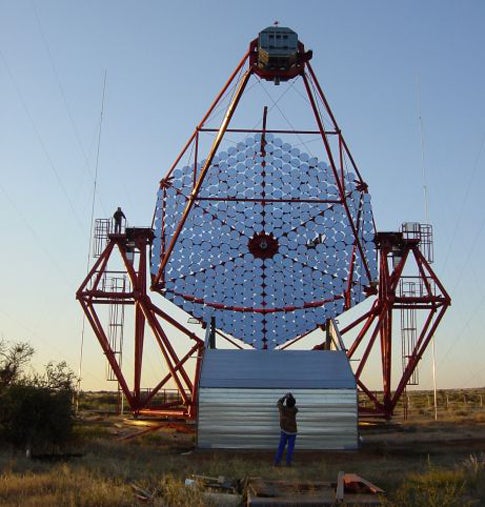The H.E.S.S. (High Energy Stereoscopic System) collaboration reports the discovery of a new type of energetic gamma-ray source, probably related to supersonic winds from massive stars in a young open stellar cluster. Dr. Olaf Reimer of the Hansen Experimental Research Laboratory and Kavli Institute for Particle Astrophysics and Cosmology of Stanford University presented the result at the First GLAST Symposium in Palo Alto, California, on behalf of a large team of international astrophysicists operating the H.E.S.S. array of gamma-ray telescopes in Namibia.
For the first time, high energy gamma-ray emission could be convincingly associated with a stellar cluster characterized by ongoing star formation and presence of massive stars near the end of their life cycle but prior to their explosion as supernovae, known as Wolf-Rayet stars. Extreme particle acceleration connected with stellar winds is becoming a phenomenon more widely observed at high energies than previously thought, and offers a hint for cosmic ray particle acceleration in other sources besides the major candidates, the relics of supernova explosions.
An international team of astrophysicists from the H.E.S.S. collaboration has announced the discovery of a new type of very-high-energy (VHE) gamma ray source. Combining data obtained during a systematic survey of the Galactic Plane and dedicated pointed observations of the telescope array revealed energetic gamma radiation coincident with the stellar cluster Westerlund 2, which is embedded in the giant ionized hydrogen cloud RCW49.
The new VHE source, HESS J1023-575, is a first indication of extreme particle acceleration associated with a young open stellar cluster, an ensemble of stars which are particularly interesting due to ongoing star formation and the existence of extremely massive stars, known as Wolf-Rayet (WR) stars. One of these, WR 20a, a close binary system of two WR stars orbiting each other, is the most massive of all confidently-measured binaries presently known in our Galaxy.
Wolf-Rayet stars (named for their discoverers) are evolved, massive stars near the end of their stellar life-cycle, when they are rapidly losing their mass by means of supersonic stellar winds. In the Westerlund 2 cluster, the Wolf-Rayet winds have literally blown bubbles around their stellar hosts, clearly visible in infrared and radio images of the region. Integrated over their lifetime, the wind energy output of Wolf-Rayet stars is not too far from the kinetic energy released in supernova explosions, and shocked winds are well suited to accelerate particles to high energy.
The energetic gamma radiation discovered by the H.E.S.S. telescopes, however, is neither point-like nor centered at the locations of the Wolf-Rayet stars, but appears extended compared to the point spread function of the telescopes, on scales beyond the extent of the stellar cluster, with constant emission over time.
What can we conclude about the origin of these gamma rays? With a projected angular size of milliarcsecond scale, the WR 20a binary system, including its colliding wind zone, would appear as a point source for observations with the H.E.S.S. telescope array. “Unless there are extreme differences in the spatial extent of the particle distributions producing radio, X-ray, and VHE gamma-ray emission”, says Olaf Reimer, Senior Research Scientist at Stanford University, “scenarios based on the colliding stellar winds in the WR 20a binary system face the severe problem of accounting for a source extension of 0.2 degrees in the VHE waveband.”
On the other hand, at the nominal distance of WR 20a of 8 kpc, this source extension is equivalent to a diameter of about 28 pc for the emission region, consistent in size with theoretical predictions of bubbles blown from massive stars into the interstellar medium.
“Shocks and turbulent motion inside a bubble can efficiently transfer energy to cosmic rays, providing a plausible mechanism for particle acceleration”, says Luke Drury, Professor at the Dublin Institute for Advanced Studies. In size and location, the gamma-ray source resembles the so-called “blister” as reported by Whiteoak & Uchida 1997, where the bubble opens up and the wind expands into the low-density ambient medium. Shock acceleration at the boundaries of the blister may enable particles to diffusively re-enter into the dense medium, thereby interacting in hadronic collisions and producing gamma-rays.
Similar scenarios were outlined over twenty years ago for supernova-driven expansion of particles into a low density medium. If one accepts such a scenario here, it might give the first observational support of energetic gamma-ray emission due to diffusive shock acceleration from supersonic winds in a wind-blown bubble created by WR 20a, or by the ensemble of hot and massive stars in Westerlund 2.










